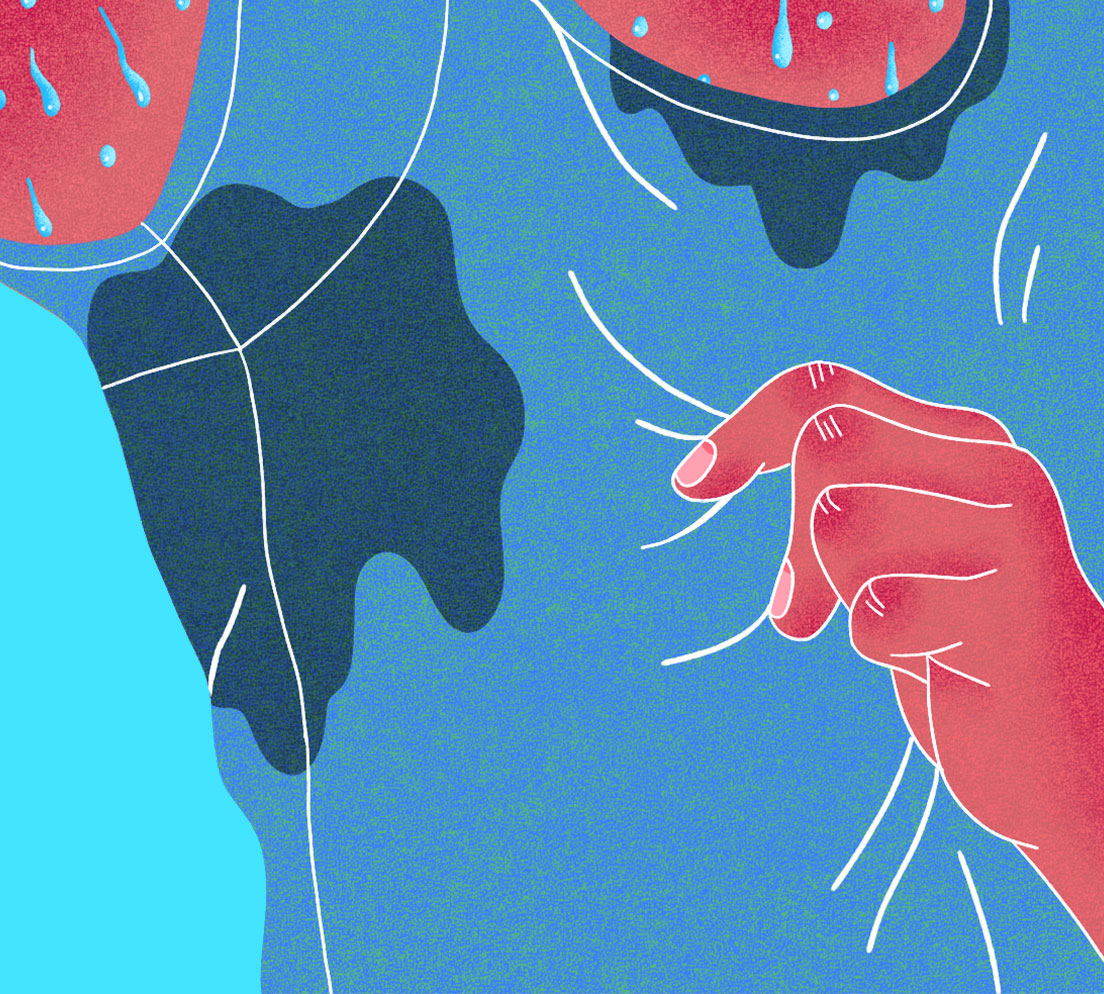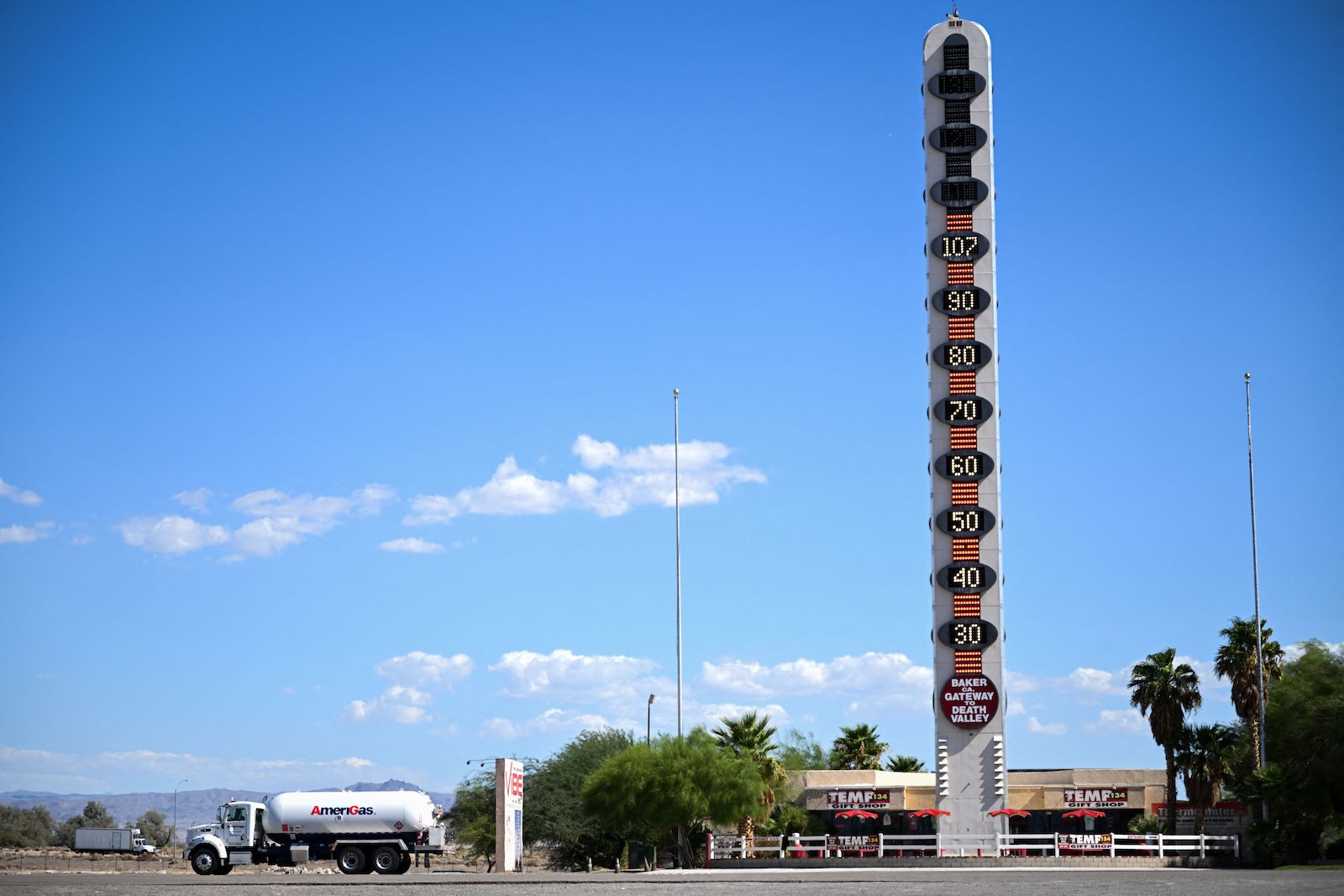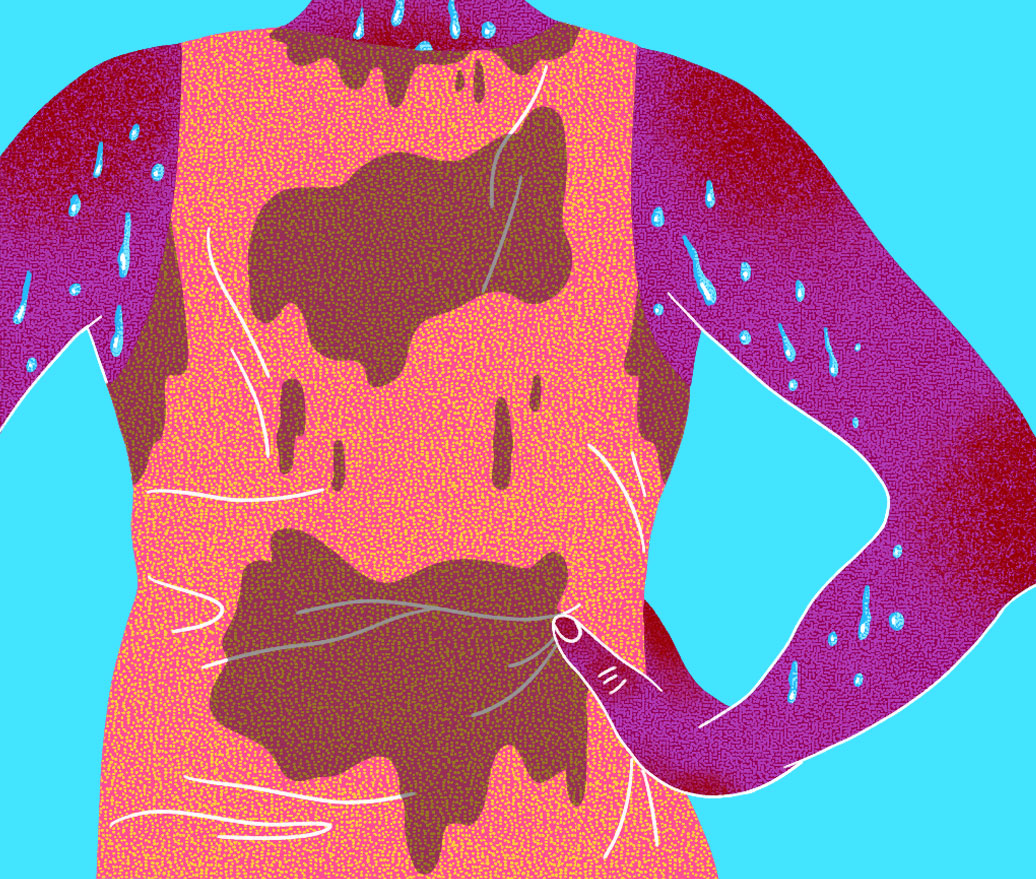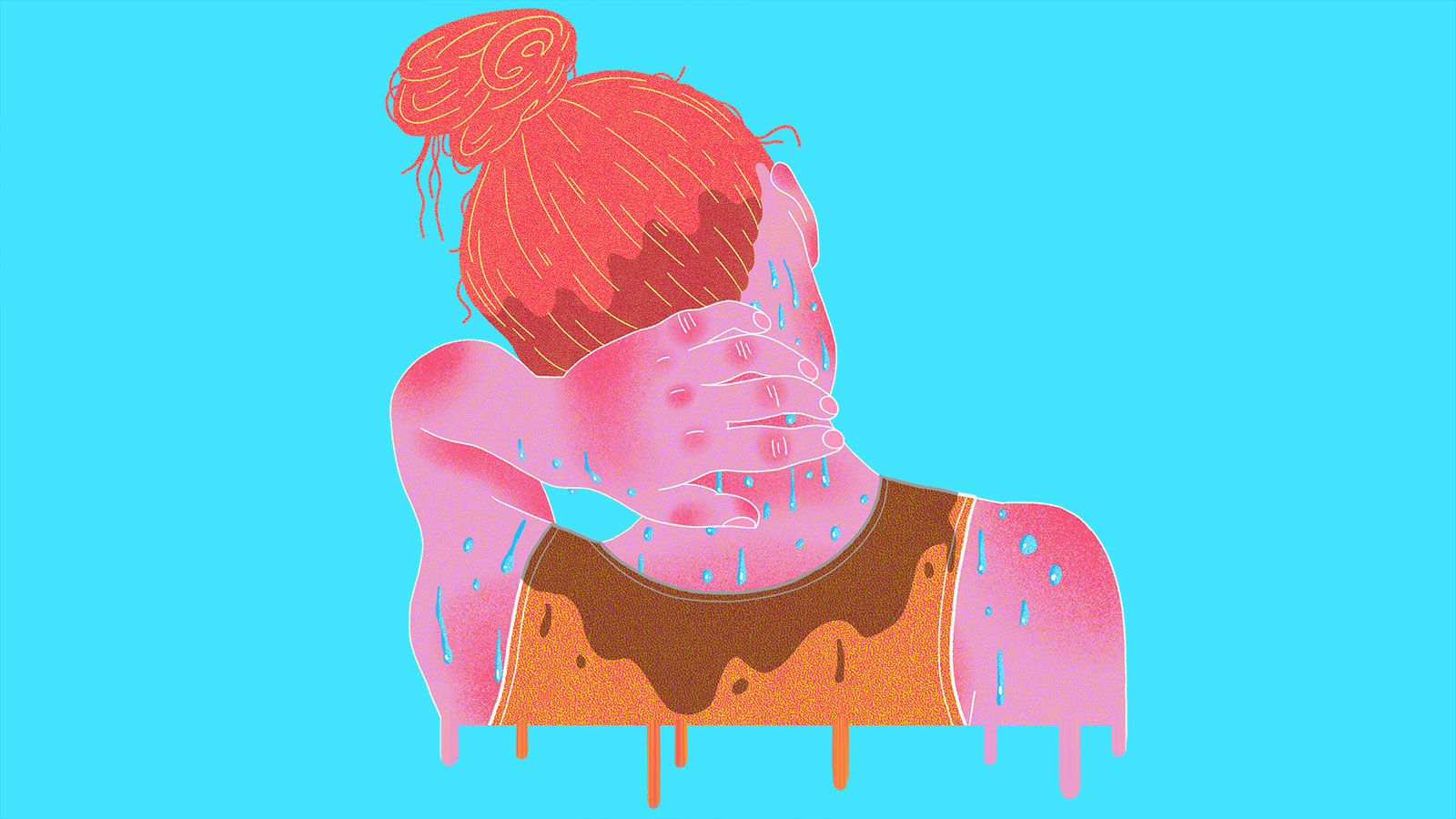This story is part of Record High, a Grist series examining extreme heat and its impact on how — and where — we live.
Under the relentless sun in Africa, the birthplace of humanity, every living thing had to find a way to beat the heat. Lions rested in the shade, termites built giant ventilation mounds, and elephants evolved giant ears that could flap like fans. Around 2 million years ago, our ancestors perfected the weirdest technique of them all: pushing water from inside our bodies to outside, a gift for enduring sweltering temperatures.
Other animals can sweat a bit, but not like us. Running around in the heat, a person can shed more than two gallons of water each day, draining one of life’s precious resources at a speedy pace. As the body tries to cool down, blood vessels widen, redirecting hot blood from the core of your body toward the surface. In tandem, sweat glands pump water, drawn from that blood, onto your skin. When those tiny beads evaporate, they carry heat off the body and into the air.
“It is crucial to being human,” said Yana Kamberov, a geneticist studying the evolution of sweat at the University of Pennsylvania. “It’s something that differentiates us from every other animal on the planet” — right up there with our oversized brains. The average person has between 2 and 4 million sweat glands in their skin, at 10 times the density of a chimpanzee’s, one of our closest living relatives. For humans, sweat proved even more useful than protective fur; our thick coat dwindled into peach fuzz to allow water to evaporate more efficiently.

Our biological sprinkler systems are now being put to the test. This summer was not just the hottest three consecutive months on record, but the hottest on Earth in 125,000 years. Phoenix spent 31 days in a row with a high of 110 degrees F or above. Across the Northern Hemisphere, from continent to continent, heat records fell at an alarming pace, with Morocco and China setting all-time highs above 120 degrees F. The swampy Gulf Coast heat soared as high as 115 degrees F, rewriting records for Houston and New Orleans. Even South America, in the throes of winter, saw unbelievable heat: A town in the Chilean Andes topped 100 degrees F — another all-time high.
It is getting to the point that life is dangerous without air-conditioning. If a widespread power outage hit Phoenix during a heat wave and lasted for days, it could kill thousands and send half the city to the emergency room, according to a recent study. And the soupy heat in the Gulf Coast comes with a challenge of its own: Super hot and humid air makes it hard for sweat to evaporate, because the environment is already thick with water molecules, which means more heat stays trapped inside the body, raising the risk of getting cooked from the inside out.
“Dying from a heat wave is like a horror movie with 27 endings that you can choose from,” said Camilo Mora, a climate scientist at the University of Hawaiʻi at Mānoa, who has cataloged 27 different ways that heat can lead to organ failure and death.
As blood gets shunted toward the skin, for instance, it strains the heart and deprives the brain and gut of oxygen, leading to heart attacks and other grisly outcomes from widespread inflammation and clotting. Prolonged sweating can also cause dehydration, sometimes inducing kidney failure. Heat has so many ways to kill you that it’s easily the deadliest of all weather disasters Americans face. In 2017, Mora and colleagues found that 30 percent of the world’s population was already exposed to potentially deadly heat for 20 days or more each year.
Given how crucial perspiration is for survival, you’d think that researchers would have the science of sweat all figured out by now, but there are still open questions. Exactly how hot is too hot for the human body? How important is humidity? And why aren’t we more grateful for sweat? Its nasty reputation for making you stink belies the fact that it’s essentially a built-in life jacket to help you ride out record-breaking heat waves.
Feeling moist and sticky is much better than the alternative — death by heat stroke. “I think it’s funny that humans have this enormous taboo about a biological function that’s ultimately going to help us survive climate change,” said Sarah Everts, the author of The Joy of Sweat.

Deadly heat can hit basically anywhere, catching people off-guard. Take the record-breaking temperatures that swept over Europe last summer, sending the thermostat soaring above 100 degrees F across the continent, resulting in more than 61,000 deaths. Our bodies can acclimatize to heat over a period of weeks, giving us the ability to sweat more. But temperatures can skyrocket quickly — in February this year, thermostats in Washington, D.C., jumped almost 30 degrees in a day, from a high of 53 degrees F one day to 81 the next. These kinds of leaps are a lot for our bodies to handle, making heat waves in cooler climates especially deadly.
Even in countries like Pakistan, where people are well-adapted to heat, sweltering temperatures are taking casualties. “With climate change, things are just going beyond limits of adaptation,” said Fahad Saeed, a scientist with the global climate policy institute Climate Analytics, who is based in Islamabad. “When you’re witnessing that in this part of the world, it really kind of tells you something is going beyond normal, because the people are acclimatized to this kind of weather, and still they are dying.”
A measure called the “wet-bulb temperature,” which combines heat and humidity with sunlight and wind speed, is used to calculate the threshold at which a healthy human body can no longer survive. Invented by the U.S. military in the 1950s after recruits kept collapsing from heat illness at a camp in South Carolina, it’s determined by covering a thermometer in a damp cloth and swinging it through the air to speed up evaporation. The theoretical point at which no amount of sweating can help you is thought to be six hours of exposure to a wet-bulb temperature of 35 degrees Celsius, or 95 degrees Fahrenheit. That translates to 95 degrees in complete humidity, for example, or 115 degrees at 50 percent humidity.
In recent years, parts of Pakistan and the Arabian Peninsula have already briefly crossed this scary threshold. And more heat will come, bringing parts of Mexico’s coasts and more of South Asia into the danger zone. Worryingly, climate change is also driving up the moisture content of the air, especially in the tropics.
Newer research suggests that the limit might be even lower than 35 degrees C. In a study last year at Penn State University, young people volunteered to subject themselves to uncomfortably hot conditions in a lab. Participants swallowed telemetry pills that monitored their core body temperature and sat in a controlled chamber, moving just enough to mimic everyday activities like cooking and eating. When the body fails to stabilize its core temperature, things start to spiral out of control: In extreme conditions, heat stroke can set in within 10 to 15 minutes. The researchers found that the upper limit of safety, based on when the participants’ core temperatures started rising, was likely closer to a wet-bulb temperature of 31 degrees C, or 88 degrees F.
And that’s for healthy people. Factors like age, illness, and body size change the math. People over the age of 60, who account for an estimated 80 percent of the 12,000 heat-related deaths in the United States each year, often have health conditions that make heat more dangerous. What’s more, as people get older, their sweat glands deteriorate, undermining their ability to cool down. Some antipsychotic medications have a side effect of suppressing sweating, possibly one of many reasons why those diagnosed with schizophrenia are particularly vulnerable to dying in the heat.
The reality is that most people don’t take all the necessary steps to stay cool during a heat wave, like seeking shade or drinking lots of cold water — another reason that a pragmatic “danger zone” for temperatures starts well below 35 degrees C. Earlier this month, researchers from the University of Oxford and the Woodwell Climate Research Center in Massachusetts analyzed the hot and humid conditions under which the human body starts to overheat unless specific actions to cool down are taken. They found that under our current climate, 8 percent of the land on Earth will meet this threshold at least once a decade. That would increase to a quarter if global temperatures warm 2 degrees C above the preindustrial average, the amount we can expect if existing and planned fossil fuel projects are carried through.

Still, there’s a debate around how much humidity matters in health outcomes, said Jane Baldwin, an Earth systems science professor at the University of California, Irvine. Humidity isn’t showing up as a key driver of deaths in real-world epidemiological data like you’d expect based on theories about wet-bulb temperature. Baldwin recently coauthored a study trying to explain this discrepancy. One explanation could be that epidemiological data tends to come from cooler parts of the world, like Europe and the United States, whereas data is limited from tropical countries like India, Ghana, and Brazil, where the link between humidity and death would likely be strongest. Nailing down an answer to this question would help scientists make more accurate predictions about how climate change will affect health, Baldwin said.
The opposite extreme — dry air — could present its own set of problems. In arid conditions, sweat evaporates very quickly. That’s great for cooling off, but sweat production has a limit, said Ollie Jay, a health professor at the University of Sydney in Australia. At rest, it’s hard to sweat more than a liter per hour, he said, but when you’re exercising, closer to three liters can pour out of your body in an hour. If you managed to reach that point of maximum sweatiness in dry heat, then you wouldn’t be able to sweat enough to cool down. “Most climate models for assessing future heat-stress risk assume that the body has an unlimited capacity to produce sweat,” Jay said, almost certainly leading to overestimates for what humans can handle in hot, arid climates.
Another unknown is just how much early exposure to heat changes our ability to sweat. One theory is that being exposed to high temperatures in the first two years of life can activate more sweat glands; we’re born with roughly the same number of sweat glands, but not all of them turn on and start pumping water. As a result, people born in hot places might have more active sweat glands than those born in cold climates.
It raises questions of whether those who spend their youth avoiding sweat-soaked clothes by hiding in artificially cooled buildings could be less prepared for life on an increasingly hot planet. “Imagine, if you raise your babies purely in air conditioning,” Kamberov said, “then in a warmer world, how capable of adapting will they be?”

Sweat is essentially saving our lives all summer long — though you probably don’t enjoy it. Everts, the author of The Joy of Sweat, speculates that it violates our desire to be in control. Sweat pours out of us involuntarily: We can’t hold it in or delay it with willpower, unlike burps or farts. “When your body gets the cooldown directive, those pores open, and the sweat pours out,” Everts said, “and there’s absolutely nothing you can do to control that, right?”
It doesn’t help that a sweaty person is often a stinky one, the curse of locker rooms everywhere. Sweat itself is odorless — it’s mostly just water — but when it mixes with bacteria on your skin, it can raise a stench. There are two types of sweat glands: Eccrine glands, the most prominent, are responsible for keeping your temperature in check and found all over the body — particularly on your forehead, palms, and the bottoms of your feet. Apocrine glands in hairy areas like the armpits and groin become active during puberty, secreting a thicker, protein-rich sweat that bacteria convert into that embarrassing aroma. Plugging your armpit pores with antiperspirant, then, won’t affect your ability to cool down: There are plenty of other escape routes on your skin.
In the olden days, people applied perfume and talcum powder to try to cover up the smell of B.O. But they were so used to it that by the time antiperspirants and deodorants came onto the market around the turn of the 20th century — the former aimed at blocking sweat pores, the latter at fighting odor-producing bacteria — hardly anyone wanted to buy them. That posed a problem for the manufacturers. So in 1919, a copywriter named James Young who was working for the antiperspirant company Odorono (odor, oh no!) “put the fear of sweat in Americans,” Everts said. One magazine ad with the headline “The most humiliating moment in my life” featured a young woman overhearing that no one would dance with her because she suffered “frightfully from perspiration.” The idea was not just to make people aware of their stink, but to make them afraid it would stop them from finding love or a decent job. “I just wish people were less mortified by sweat,” Everts said.
The marketing campaign was a lasting success, even a century later. Last year, the global deodorant market was valued at $24 billion, and it’s on track to grow to $37 billion by the end of the decade, in part because of global warming, according to the market research firm Fortune Business Insights.

Today, some cultures are more matter-of-fact about sweat than others. In Pakistan, it’s simply a fact of life, Saeed said. Still, excessive sweating is frowned upon basically everywhere. “What can save you is not culturally accepted,” said Mora, the University of Hawaiʻi scientist. “I cannot imagine anywhere in the world where you would like to be hugged by a sweaty person.”
How sweaty you are isn’t in your control — but what you wear is. Hot, humid climates call for more exposed skin, making it easier for your sweat to evaporate; perhaps counterintuitively, loose, long sleeves and pants help you reap the benefits of sweat in arid climates, keeping the water from evaporating too quickly and at the same time blocking sunlight. Konrad Rykaczewski, a professor of engineering at Arizona State University, is researching how to help design clothing that maximizes the effectiveness of sweating. He says that scientists still don’t understand a lot about sweat on the scale that really matters for clothing design.
“The question is, how much of the sweat we produce actually goes to cooling us?” Rykaczewski said. Sweating profusely isn’t helping anyone — sweat that drips off your forehead is essentially wasted water, since it didn’t evaporate off you. By the same token, trapping a bunch of sweat underneath a hazmat suit could leave you susceptible to heat illnesses. Counterintuitively, even fabrics that wick sweat can end up stealing it away from your skin and wasting it, Rykaczewski said. When that water evaporates, it’ll cool the fabric and the air between the fabric and your skin, instead of your body directly.
Rykaczewski’s research is focused on understanding how heat affects the human body in the real world, something that’s difficult to study. “No one’s measuring someone that’s going to get heatstroke, right?” Rykaczewski said. “That’s not ethical.”

So, in place of live humans, he and his colleagues at Arizona State have developed a sweating robot, technically called a “thermal mannequin,” that simulates human responses to super-hot temperatures. The robot — named ANDI for “Advanced Newton Dynamic Instrument” — takes frequent trips into the sizzling Arizona heat, equipped with sensors, an internal cooling system, as well as pores for sweating. One unique thing about ANDI is that it can represent anyone. Rykaczewski can modify the program to simulate how a person might weather the heat, calculating how factors like age, body size, or drug use might affect the body’s response in different situations. And it all comes at the low cost of $650,000. “We basically are developing the most expensive way to measure heat impacts on humans,” Rykaczewski joked.
ANDI is essentially a crash test dummy for a hotter planet. Our bodies are up against heat that threatens to render our dampness useless. Humans have been sweating for hundreds of thousands of years, and it’s core to who we are. But to truly understand it? For that, we needed to build a robot.



